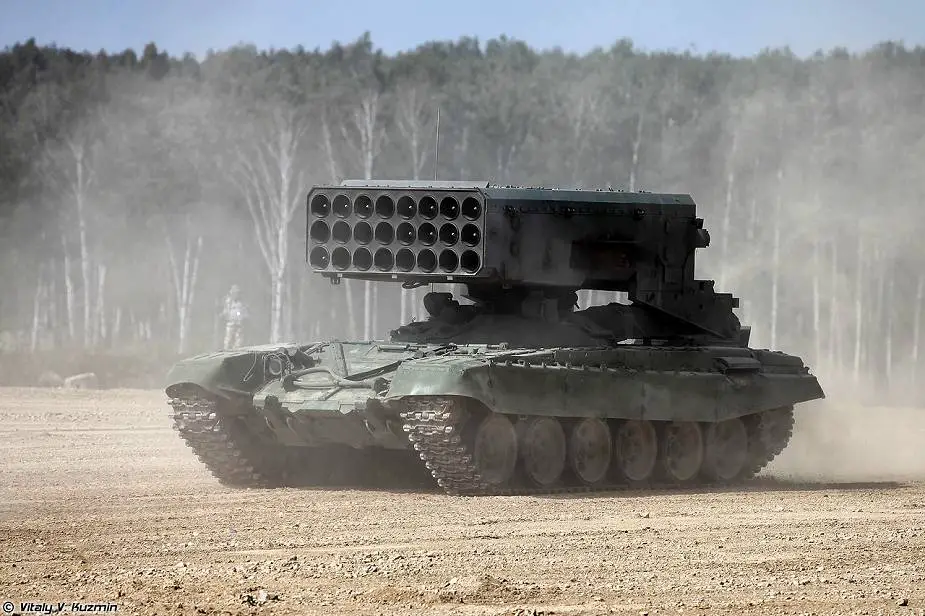Russian TOS-1A thermobaric rockets deployed in Bakhmut battle for urban warfare
According to information published by the Russian Ministry of Defense, the Russian airborne troops received TOS-1A heavy flamethrower systems that are widely used in the battle for the conquest of the city of Barkmut. The vehicle is considered a terror weapon due to its destructive capabilities and the use of thermobaric rockets. In summary, the thermobaric effect is characterized by the release and ignition of a fuel-air mixture, resulting in a powerful blast wave, intense heat, and oxygen depletion.
Follow Army Recognition on Google News at this link

Aerial view of the Russian TOS-1A heavy flamethrower systems fire on the city of Bakhmut. (Picture source Screenshot Videos Telegram)
In a recent development, the Russian Ministry of Defense (MoD) and Prigozhin have stated that Wagner Group mercenaries are leading the primary campaign to seize territory and drive back Ukrainian forces in the central Bakhmut region. Unnamed Russian Airborne (VDV) units are playing a supporting role, flanking Wagner fighters to the north and south of Bakhmut, including in areas such as Zalizhnyanske, Sakko i Vantsetti, and Mykolaivka.
The Russian VDV forces are reportedly focused on maintaining these flanks rather than advancing further into the conflict. This strategic deployment of forces implies that the Russian MoD aims to utilize the Wagner Group in capturing Bakhmut while minimizing casualties among traditional Russian troops. This approach aligns with previous assessments from the Institute for the Study of War (ISW), which suggest that the MoD plans to use Wagner forces to secure Bakhmut and then replace them, ultimately claiming victory for themselves.
Recent reports indicate that the allocation of TOS-1A thermobaric artillery systems to Russian Airborne (VDV) forces on April 3 may involve VDV units operating in the vicinity of Bakhmut. The Institute for the Study of War (ISW) has observed VDV forces, including the 76th and 106th Guards Airborne divisions, active in the Bakhmut region. Moreover, combat footage from April 5 reveals Russian forces employing a TOS-1A to strike targets within Bakhmut.
Despite the deployment of this powerful military-district level asset, the ISW maintains its assessment that the presence of the TOS-1A will not grant Russian forces a definitive offensive advantage in Bakhmut operations.
The TOS-1A is a Russian heavy flamethrower system, also known as the "Solntsepyok" (translated to "Blazing Sun" or "Sunheat"). It is a thermobaric artillery system mounted on a modified T-72 tank chassis. The TOS-1A is designed for close-range fire support in urban and fortified areas, as well as against enemy personnel in open or rough terrain.
The system is equipped with a multiple-launch rocket system (MLRS) that can fire unguided rockets with thermobaric warheads. Thermobaric weapons, also known as fuel-air explosives or vacuum bombs, release a cloud of fuel that ignites upon contact with oxygen, creating a massive blast wave and intense heat. The resulting explosion has a devastating effect on both personnel and structures, making the TOS-1A a highly effective weapon in certain combat situations.
Using thermobaric rockets in urban environments brings both tactical benefits and challenges for military forces due to their unique properties. These weapons offer enhanced destructive capabilities, making them effective at neutralizing enemy fortifications and structures, which can be advantageous in urban combat. Additionally, the blast wave from thermobaric weapons can cause serious injuries to enemy personnel, potentially providing a strategic edge.
However, there are also concerns related to precision targeting, particularly with unguided rockets, which may result in collateral damage and civilian casualties. This issue could be mitigated by employing guided munitions or advanced targeting systems, but accuracy remains a challenge in populated areas.

Russian army TOS-1A heavy flamethrower rocket launcher system. (Picture source Vitaly Kuzmin)

























